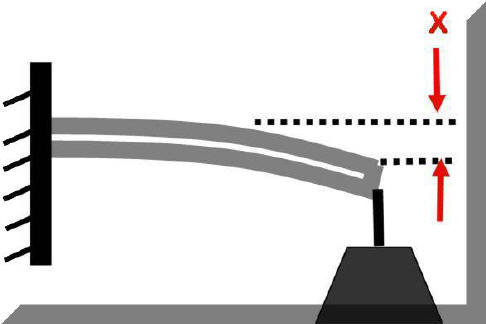Bob,
I completly agree with what you are saying about stiffness
When I did my reseasrch, I found this site, it has some very usefull information
Metilurgical Definitions
Here is a short piece from the site
Stiffness:
The amount the beam or tubing will bend is NOT determined by its strength! For steel, mild steel with 40,000 psi strength and quenched 4130 with 250,000 psi will bend or defect the same amount! That assumes the same size beam or tube, the same wall thickness etc. It is a property of steel called Modulus of Elasticity and all steel is essentially the same! It also assumes the beam or tube does not exceed the
elastic limit, i.e. the beam will return to its original position when the load is removed, it will not be loaded to the
yield strength . A higher strength steel will bend more than mild steel before that happens.
Then why do some folks say 4130 tube is stiffer. The structure can be "stiffer" if for example a tube is made larger. Since it is stronger it can also be made thinner but then it will bend more! There are equations that can predict “stiffness” or how much a given design will bend. For example the “stiffness” will increase by the tube diameter cubed (D<SUP>3</SUP>)so a little increase in diameter goes a long way in increasing this parameter.
Here are some examples for steel tubes of how "stiffness" can be increased or weight reduced for the same "stiffness":
·A
3 inch diameter steel tube with an
0.062 wall is
18% “stiffer” or deflect 18% less than a 2.5 inch diameter tube with a 0.093 wall thickness and is 7% lighter per foot.
·A
2.25 inch diameter tube with an
0.062 wall thickness is about the same stiffness and weights 10% less per foot than the 2 inch 0.093 wall tube.
·A
2.5 inch diameter tube with an
0.062 wall thickness is about the same stiffness and weights 27% less per foot than the 2 inch 0.125 wall tube.
Therefore a normalized 4130 tube may be useful since it is about twice as strong as mild steel and therefore it should be capable of handling the higher stress imposed on a thinner wall tube. But be careful and don't go so thin that
local bucking is encountered!
How about using other materials to make a "stiffer" structure. The following table provides a comparison of steel with some other materials based on mild steel bending a distance l for a given weight W:
<!--mstheme--><TABLE style="BORDER-COLLAPSE: collapse" id=AutoNumber2 border=1 cellSpacing=1 borderColorLight=#cccc99 borderColorDark=#999966 width="100%"><TBODY><TR><TD style="BORDER-BOTTOM: 3px double; BORDER-LEFT: 3px double; PADDING-LEFT: 4px; PADDING-RIGHT: 4px; BORDER-TOP-WIDTH: 3px; BORDER-RIGHT: 3px double" borderColor=#cccc99 width="25%" align=middle><!--mstheme-->
Material<!--mstheme--></TD><TD style="BORDER-BOTTOM: 3px double; BORDER-LEFT: 3px double; PADDING-LEFT: 4px; PADDING-RIGHT: 4px; BORDER-TOP-WIDTH: 3px; BORDER-RIGHT: #ffff00 3px double" width="25%" align=middle><!--mstheme-->
For a Load W, X= ?<!--mstheme--></TD><TD style="BORDER-BOTTOM: 3px double; BORDER-LEFT: 3px double; PADDING-LEFT: 4px; PADDING-RIGHT: 4px; BORDER-TOP-WIDTH: 3px; BORDER-RIGHT: 3px double" borderColor=#cccc99 width="25%" align=middle><!--mstheme-->
Material<!--mstheme--></TD><TD style="BORDER-BOTTOM: 3px double; BORDER-LEFT: 3px double; PADDING-LEFT: 4px; PADDING-RIGHT: 4px; BORDER-TOP-WIDTH: 3px; BORDER-RIGHT: 3px double" borderColor=#cccc99 width="25%" align=middle><!--mstheme-->
For a Load W, X= ?<!--mstheme--></TD></TR><TR><TD style="BORDER-BOTTOM: 3px double; BORDER-LEFT: 3px double; PADDING-LEFT: 4px; PADDING-RIGHT: 4px; BORDER-TOP-WIDTH: 3px; BORDER-RIGHT: 3px double" borderColor=#cccc99 width="25%" align=middle><!--mstheme-->Mild Steel<!--mstheme--></TD><TD style="BORDER-BOTTOM: 3px double; BORDER-LEFT: 3px double; PADDING-LEFT: 4px; PADDING-RIGHT: 4px; BORDER-TOP-WIDTH: 3px; BORDER-RIGHT: #ffff00 3px double" width="25%" align=middle><!--mstheme-->l<!--mstheme--></TD><TD style="BORDER-BOTTOM: 3px double; BORDER-LEFT: 3px double; PADDING-LEFT: 4px; PADDING-RIGHT: 4px; BORDER-TOP-WIDTH: 3px; BORDER-RIGHT: 3px double" borderColor=#cccc99 width="25%" align=middle><!--mstheme-->Titanium<!--mstheme--></TD><TD style="BORDER-BOTTOM: 3px double; BORDER-LEFT: 3px double; PADDING-LEFT: 4px; PADDING-RIGHT: 4px; BORDER-TOP-WIDTH: 3px; BORDER-RIGHT: 3px double" borderColor=#cccc99 width="25%" align=middle><!--mstheme-->2 x l<!--mstheme--></TD></TR><TR><TD style="BORDER-BOTTOM: 3px double; BORDER-LEFT: 3px double; PADDING-LEFT: 4px; PADDING-RIGHT: 4px; BORDER-TOP-WIDTH: 3px; BORDER-RIGHT: 3px double" borderColor=#cccc99 width="25%" align=middle><!--mstheme-->Normalized 4130 <!--mstheme--></TD><TD style="BORDER-BOTTOM: 3px double; BORDER-LEFT: 3px double; PADDING-LEFT: 4px; PADDING-RIGHT: 4px; BORDER-TOP-WIDTH: 3px; BORDER-RIGHT: #ffff00 3px double" width="25%" align=middle><!--mstheme-->l<!--mstheme--></TD><TD style="BORDER-BOTTOM: 3px double; BORDER-LEFT: 3px double; PADDING-LEFT: 4px; PADDING-RIGHT: 4px; BORDER-TOP-WIDTH: 3px; BORDER-RIGHT: 3px double" borderColor=#cccc99 width="25%" align=middle><!--mstheme-->Carbon Fiber<!--mstheme--></TD><TD style="BORDER-BOTTOM: 3px double; BORDER-LEFT: 3px double; PADDING-LEFT: 4px; PADDING-RIGHT: 4px; BORDER-TOP-WIDTH: 3px; BORDER-RIGHT: 3px double" borderColor=#cccc99 width="25%" align=middle><!--mstheme-->0.9 x l<!--mstheme--></TD></TR><TR><TD style="BORDER-BOTTOM: 3px double; BORDER-LEFT: 3px double; PADDING-LEFT: 4px; PADDING-RIGHT: 4px; BORDER-TOP-WIDTH: 3px; BORDER-RIGHT: 3px double" borderColor=#cccc99 width="25%" align=middle><!--mstheme-->Heat Treated 4130<!--mstheme--></TD><TD style="BORDER-BOTTOM: 3px double; BORDER-LEFT: 3px double; PADDING-LEFT: 4px; PADDING-RIGHT: 4px; BORDER-TOP-WIDTH: 3px; BORDER-RIGHT: #ffff00 3px double" width="25%" align=middle><!--mstheme-->l<!--mstheme--></TD><TD style="BORDER-BOTTOM: 3px double; BORDER-LEFT: 3px double; PADDING-LEFT: 4px; PADDING-RIGHT: 4px; BORDER-TOP-WIDTH: 3px; BORDER-RIGHT: 3px double" borderColor=#cccc99 width="25%" align=middle><!--mstheme-->Alumina Ceramic<!--mstheme--></TD><TD style="BORDER-BOTTOM: 3px double; BORDER-LEFT: 3px double; PADDING-LEFT: 4px; PADDING-RIGHT: 4px; BORDER-TOP-WIDTH: 3px; BORDER-RIGHT: 3px double" borderColor=#cccc99 width="25%" align=middle><!--mstheme-->0.6 x l<!--mstheme--></TD></TR><TR><TD style="BORDER-BOTTOM: 3px double; BORDER-LEFT: 3px double; PADDING-LEFT: 4px; PADDING-RIGHT: 4px; BORDER-TOP-WIDTH: 3px; BORDER-RIGHT: 3px double" borderColor=#cccc99 width="25%" align=middle><!--mstheme-->Aluminum<!--mstheme--></TD><TD style="BORDER-BOTTOM: 3px double; BORDER-LEFT: 3px double; PADDING-LEFT: 4px; PADDING-RIGHT: 4px; BORDER-TOP-WIDTH: 3px; BORDER-RIGHT: #ffff00 3px double" width="25%" align=middle><!--mstheme-->3 x l<!--mstheme--></TD><TD style="BORDER-BOTTOM: 3px double; BORDER-LEFT: 3px double; PADDING-LEFT: 4px; PADDING-RIGHT: 4px; BORDER-TOP-WIDTH: 3px; BORDER-RIGHT: 3px double" borderColor=#cccc99 width="25%" align=middle><!--mstheme-->Diamond<!--mstheme--></TD><TD style="BORDER-BOTTOM: 3px double; BORDER-LEFT: 3px double; PADDING-LEFT: 4px; PADDING-RIGHT: 4px; BORDER-TOP-WIDTH: 3px; BORDER-RIGHT: 3px double" borderColor=#cccc99 width="25%" align=middle><!--mstheme-->0.1 x l<!--mstheme--></TD></TR></TBODY></TABLE><!--mstheme-->
Note aluminum and titanium bend considerable more than steel! Of interest their “stiffness” as measured by the Modulus of Elasticity of aluminum and titanium is about the opposite of their weight compared to steel therefore the stiffness to weight ratio is about equal for all three!
As you say Bob, its quite amazing how structual matals have very close numbers
Metin,
There are quite a lot of pics to be found on this site, just look through the pic gallery, it may take a long time, but you will find lots of pics
If you do a google search on the chassis I have mentioned you will find some intresting sites. Also do a search on Lotus Cosworth 25, and 49.
Just keep serching the internet. there is lots of information to be found


